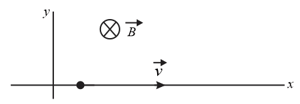Lorentz Force
Important Questions on Lorentz Force
A particle of mass , carrying charge is accelerated through a potential of . When this accelerated charge comes under the influence of perpendicular magnetic field, the force acting on it is:
The period of revolution of a charged particle inside a cyclotron does not depend on:
Which of the following is the correct expression of the velocity selector?
A particle having mass and charge is released from the origin in a region in which electric field and magnetic field are given by
.
Find the speed of the particle as a function of its coordinate.
Describe the working of cyclotron. Draw the diagram showing path of particle in both "Dees" Derive expression for frequency of cyclotron.
In the given figure, an electron moves at speed along an -axis, through uniform electric and magnetic fields. The magnetic field is directed into the page and has magnitude . In unit-vector notation, what is the electric field?

If instead of electron a neutron enters a field, what will be its direction of motion? Give reasons for your answer.
(a)A monoenergetic electron beam with electron speed of is subject to a magnetic field of normal to the beam velocity. What is the radius of the circle traced by the beam, given for electron equals .
(b)Is the formula you employ in (a) valid for calculating radius of the path of a electron beam? If not, in what way is it modified?
Answer the following question:
Interstellar space has an extremely weak magnetic field of the order of . Can such a weak field be of any significant consequence? Explain.
A magnetic field set up using Helmholtz coils is uniform in a small region and has a magnitude of . In the same region, a uniform electrostatic field is maintained in a direction normal to the common axis of the coils. A narrow beam of (single species) charged particles all accelerated through enters this region in a direction perpendicular to both the axis of the coils and the electrostatic field. If the beam remains undeflected when the electrostatic field is , make a simple guess as to what the beam contains. Why is the answer not unique?
A charged particle enters an environment of a strong and non-uniform magnetic field varying from point to point both in magnitude and direction and comes out of it following a complicated trajectory. Would its final speed equal the initial speed if it suffered no collisions with the environment?
A magnetic field that varies in magnitude from point to point but has a constant direction (east to west) is set up in a chamber. A charged particle enters the chamber and travels undeflected along a straight path with constant speed. What can you say about the initial velocity of the particle?
In a certain region of space, electric field and magnetic field are perpendicular to each other and an electron enters in the region perpendicular to the direction of and both and moves undeviated, then velocity of electron is -
A charged particle with charge enters a region of constant, uniform and mutually orthogonal fields and with a velocity perpendicular to both and , and comes out without any change in magnitude or direction of . Then,
In a region, steady and uniform electric and magnetic fields are present. These two fields are parallel to each other. A charged particle is released from rest in this region. The path of the particle will be,
The time period of a charged particle undergoing a circular motion in a uniform magnetic field is independent of its
If an electron and a proton having the same momentum enter perpendicular to a magnetic field, then_____.

